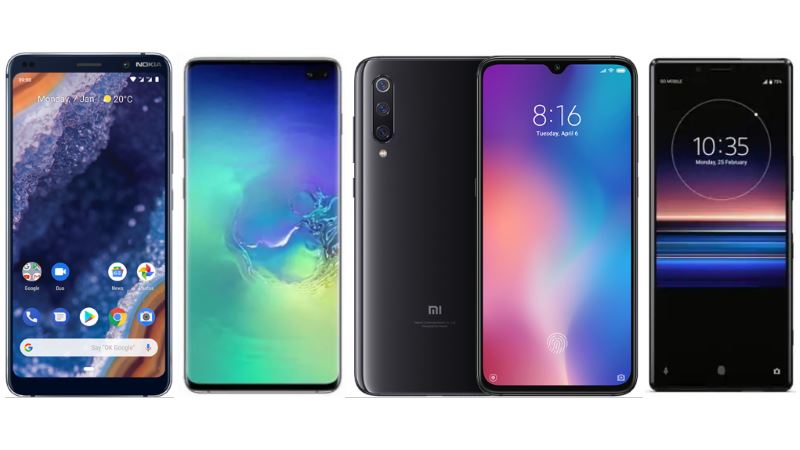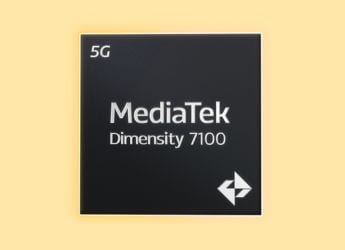- Home
- Mobiles
- Mobiles Features
- Nokia 9 PureView vs Samsung Galaxy S10+ vs Mi 9 vs Sony Xperia 1: Price, Specifications Compared
Nokia 9 PureView vs Samsung Galaxy S10+ vs Mi 9 vs Sony Xperia 1: Price, Specifications Compared

Nokia 9 PureView is targeted at photography enthusiasts
Nokia 9 PureView made its official debut in Barcelona on Sunday. This latest flagship smartphone is targeted at the consumers, who love photography and are looking to try new and interesting technologies in the space. The Nokia 9 PureView comes with as many as five rear cameras, all of which are triggered when a picture is taken. The phone then fuses the data from the five cameras to generate a single image, which the company claims is “the richest image capture possible.” Although there aren't any other smartphones in market with five rear cameras, the Nokia 9 will be taking on the likes of Samsung Galaxy S10+, Xiaomi Mi 9, and Sony Xperia 1, all of which come with three cameras on the back and claim to offer an amazing imaging experience.
In this article, we compare the Nokia 9 PureView, Samsung Galaxy S10+, Xiaomi Mi 9, and Sony Xperia 1 smartphones to take a look at how the four phones stack up to each other. All four phones are the flagship models of the respective smartphone makers and will go on sale in select markets around the world over the coming weeks.
Nokia 9 PureView With Penta-Lens Camera, Snapdragon 845 SoC Launched at MWC 2019
Nokia 9 PureView vs Samsung Galaxy S10+ vs Xiaomi Mi 9 vs Sony Xperia 1 price
According to HMD Global, the Nokia brand licensee, the Nokia 9 PureView will carry a price tag of $699 (roughly Rs. 50,000) for the sole 6GB + 128GB version. On the other hand, the Samsung Galaxy S10+ will retail at $999 (roughly Rs. 71,300) for the 8GB + 128GB model, $1249.99 (roughly Rs. 89,200) for the 8GB + 512GB model, and $1599.99 (roughly Rs. 1,14,100) for the 12GB + 1TB model. The Xiaomi Mi 9 will be sold at CNY 2,999 (roughly Rs. 31,800) for the 6GB + 128GB variant and CNY 3,299 (roughly Rs. 34,900) for 8GB + 128GB variant. Xiaomi is also selling a 6GB + 64GB model of the Mi 9 in Europe, which will be offered at EUR 449 (roughly Rs. 36,200). Sony is yet to reveal the pricing for the Xperia 1, however some reports indicate that the phone will retail starting GBP 799 (roughly Rs. 73,600).
Nokia 9 PureView vs Samsung Galaxy S10+ vs Xiaomi Mi 9 vs Sony Xperia 1 specifications
HMD Global has included a 5.99-inch Quad-HD+ (1440x2960 pixels) POLED screen with 18.5:9 aspect ratio on the Nokia 9 PureView, whereas the Galaxy S10+ packs a 6.4-inch Quad-HD+ (3040x1440 pixels) Dynamic AMOLED screen with 19:9 aspect ratio. On the other hand, the Xiaomi Mi 9 has a 6.39-inch Full-HD+ (1080x2340 pixels) screen with 19.5:9 aspect ratio, and the Sony Xperia features a 6.50-inch 4K (1644x3840 pixels) HDR OLED screen with 21:9 aspect ratio.
Under the hood, the Nokia 9 PureView comes with older Qualcomm Snapdragon 845 SoC, whereas the Samsung Galaxy S10+, Xiaomi Mi 9, and Sony Xperia 1 are powered by the latest Qualcomm Snapdragon 855 SoC. It is important to note here that in some regions, Galaxy S10+ will come with Exynos 9820 SoC, instead of Snapdragon 855. Additionally, the Nokia phone includes 6GB of RAM and 128GB of inbuilt storage, same as the Xperia 1 and Mi 9 base model. However, the Galaxy S10+ has 8GB of RAM and 128GB of storage in its base variant, which goes up to 12GB of RAM and 1TB of storage. The Xperia 1 and Galaxy S10+ also feature microSD card slot for further storage expansion, whereas the Mi 9 is missing the slot and the same is unconfirmed for the Nokia 9 PureView at this point.
Samsung Galaxy S10, Galaxy S10+, Galaxy S10e Unveiled
Moving on to the camera capabilities, which are the USP of the Nokia 9 PureView, the Nokia phone packs five rear cameras with Zeiss certified f/1.82 lenses, which are joined by three 12-megapixel monochrome sensors and two 12-megapixel RGB sensors. In the front, there is a 20-megapixel selfie shooter. In comparison, the Samsung Galaxy S10+ comes with a triple camera setup with a 12-megapixel sensor with a telephoto f/2.4 lens, a 12-megapixel sensor with wide-angle f/1.5 to f/2.4 lens, and a 16-megapixel sensor with ultra-wide-angle f/2.2 fixed-focus lens. There are two cameras on the front of the Galaxy S10+ with a 10-megapixel sensor with an f/1.9 lens and a 8-megapixel RGB depth sensor with an f/2.2 lens. The Xiaomi Mi 9 also has three cameras on the back, but with a 48-megapixel primary sensor with an f/2.2 lens, a 16-megapixel sensor with an ultra-wide angle f2.2 lens, and a 12-megapixel sensor with telephoto f2.2 lens. For selfies, there is a single 20-megapixel sensor on the front with f2.0 lens. Lastly, the Sony Xperia 1 sports three cameras as well, but with a 12-megapixel primary sensor with an f/1.6 lens, a 12-megapixel secondary sensor with wide-angle f/2.4 lens, and a 12-megapixel sensor with f/2.4 lens. There is also an 8-megapixel sensor at the front for selfies with f/2.0 lens.
Coming to the onboard battery, the Nokia 9 PureView includes a 3,320mAh battery, whereas the Galaxy S10+ packs a 4,100mAh battery, Xiaomi Mi 9 comes with a 3,300mAh battery, and Sony Xperia 1 features a 3,300mAh battery. All phones except Sony Xperia 1 include fast charging as well as wireless charging support. Galaxy S10+ also includes reverse wireless charging.
Mi 9 With Triple Rear Cameras, 20W Fast Charging Support Launched
Among other features, all four phones include fingerprint sensor, Android 9.0, Wi-Fi 5 (S10+ has Wi-Fi 6), Bluetooth 5.0, NFC, USB Type-C, dual-SIM support, 4G LTE, and the usual set of sensors.
With Galaxy Fold, has Samsung kicked off a revolution in smartphone tech? We discussed this on Orbital, our weekly technology podcast, which you can subscribe to via Apple Podcasts or RSS, download the episode, or just hit the play button below.
Catch the latest from the Consumer Electronics Show on Gadgets 360, at our CES 2026 hub.
Related Stories
- Samsung Galaxy Unpacked 2025
- ChatGPT
- Redmi Note 14 Pro+
- iPhone 16
- Apple Vision Pro
- Oneplus 12
- OnePlus Nord CE 3 Lite 5G
- iPhone 13
- Xiaomi 14 Pro
- Oppo Find N3
- Tecno Spark Go (2023)
- Realme V30
- Best Phones Under 25000
- Samsung Galaxy S24 Series
- Cryptocurrency
- iQoo 12
- Samsung Galaxy S24 Ultra
- Giottus
- Samsung Galaxy Z Flip 5
- Apple 'Scary Fast'
- Housefull 5
- GoPro Hero 12 Black Review
- Invincible Season 2
- JioGlass
- HD Ready TV
- Laptop Under 50000
- Smartwatch Under 10000
- Latest Mobile Phones
- Compare Phones
- OPPO Reno 15 Pro Max
- Honor Win RT
- Honor Win
- Xiaomi 17 Ultra Leica Edition
- Xiaomi 17 Ultra
- Huawei Nova 15
- Huawei Nova 15 Pro
- Huawei Nova 15 Ultra
- Asus ProArt P16
- MacBook Pro 14-inch (M5, 2025)
- OPPO Pad Air 5
- Huawei MatePad 11.5 (2026)
- Xiaomi Watch 5
- Huawei Watch 10th Anniversary Edition
- Acerpure Nitro Z Series 100-inch QLED TV
- Samsung 43 Inch LED Ultra HD (4K) Smart TV (UA43UE81AFULXL)
- Asus ROG Ally
- Nintendo Switch Lite
- Haier 1.6 Ton 5 Star Inverter Split AC (HSU19G-MZAID5BN-INV)
- Haier 1.6 Ton 5 Star Inverter Split AC (HSU19G-MZAIM5BN-INV)

















